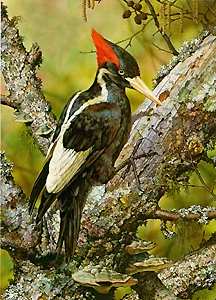ivory-billed woodpecker find by Man

ivory billed woodpecker
Gene Sparling was kayaking when he spotted a large black-and-white bird. It looked like an ivory-billed woodpecker, last spotted in North America 60 years ago.
His eyes must be playing tricks, he thought. Maybe it was a common pileated woodpecker.
"As a young birder, I used to dream of finding a lost colony of ivory-billed woodpeckers. It was just too miraculous to imagine," Sparling said Thursday after a news conference in Washington where he joined federal officials in announcing his sighting.
Sparling spotted the ivory-billed woodpecker on February 11, 2004, along the Cache River in eastern Arkansas, but wasn't sure how to let others know about his find. He recognized the bird from his readings as an amateur bird watcher and bird photographer.
"I was very familiar with the legend of the ivory-billed," said Sparling, who lives in Hot Springs.
The species is one of six North American bird species thought to have become extinct since 1880. Indians believed the bird's bill had magical powers. Its habitat was largely eliminated between 1880 and the 1940s because of logging. The last official ivory-bill sighting was in 1944 in northern Louisiana.
Via CNN
ivory-billed woodpecker,
common name for the largest of the North American woodpeckers, Campephilus principalis. Believed since 1952 to be nearing extinction, the last known members of this species were reported from the deepest forests of NW Florida and central Louisiana. A shiny blue-black in color with extensive white markings on its wings and neck, this bird is distinguished by its pure white bill and by a prominent top crest, red in the male and black in the female. A true woodpecker, it has a strong and straight chisellike bill and a long, mobile, hard-tipped, sticky tongue. It measures from 18 to 20 in. (46—51 cm) in length, with short legs and feet ending in large, curved claws. The ivory-bill deposits from three to five glossy white eggs per clutch in an unlined hole, preferably drilled in a cypress tree. Of its reproductive habits little more than this is known. The disappearance of the ivory-bills may be blamed on the cutting and eventual disappearance of the trees in which they lived. It is thought that a few ivory-bills are surviving today in the forests of the Gulf Coast of North America and in Cuba. Ivory-billed woodpeckers are classified in the phylum Chordata, subphylum Vertebrata, class Aves, order Piciformes, family Picidae.

0 Comments:
Post a Comment
<< Home